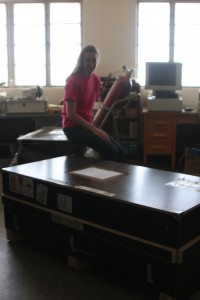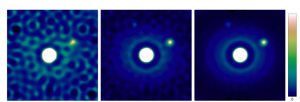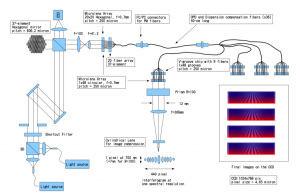FIRST@LICK: The Project
Keck AO Observations: Multiple Asteroid Systems
July 20, 2010FIRST@LICK: Setting up the prototype
July 25, 2010On July 13, I received a short email from Elinor Gates, my colleague at Lick Observatory: “The two crates arrived. I will have them moved into the lab later today.” Below a picture of these mysterious black crates. What can we find inside these crates shipped from Observatoire de Paris-Meudon? Not a vampire as you may think, but the parts of an innovative instrument. That’s a long story that I summarize briefly today.
During a long stay at Keck Observatory in Hawaii in Janury 2009 (see my post here and here), I mentioned my friends and colleagues Olivier Lai from CFHT and Julien Woillez from Keck Observatory, my desire to move new challenges challenges related to instrument and its applications as I did during my Ph.D. I, indeed, enjoyed this special time of life working at La Silla Observatory in the ESO-3.6m crew when I was testing one of the first Adaptive Optics system (called ADONIS) and used it for scientific applications. This work led to numerous fun and interesting results such as the first observations of Io volcanoes from the ground, the discovery of the bilobated shape of the asteroid (216) Kleopatra and so on. I cannot count the number of nights I spent over there, setting up a new detector or wavefront sensor, learning about its capabilities and how to use it in an optimal way for future scientific applications. It was intense, but it was fun and it was extremely rewarding.
During one of our numerous coffee break discussions, Julien mentioned to me the FIRST (Fibered Imager foR Single Telescope) project led by Guy Perrin and Sylvestre Lacour, astronomers at the Observatoire de Paris. This instrument concept was described in an article published in 2006 (High dynamic range imaging by pupil single-mode filtering and remapping). A second article published in 2007 validated the concept by simulations and showed that high-contrast can be reach (up to 10^6). Finally, in 2009 a testbench was built and the first lab result was published by Takayuki Kotani and his colleagues.
To summarize the concept in a few words, after partial correction using an adaptive optics system, the flux of the pupil of the telescope is injected in several single-mode fibers (9 in the current testbench) which are combined to an array of fringes in one direction and a low resolution spectra in the other one. An image is reconstructed by measuring the visibility and the closure phase using well-known interferometric techniques. This instrument uses the filtering properties of single-mode fibers to get ride of phase aberrations remaining after correction with an adaptive optics system providing an “image” with a contrast of 10^6 and allowing us to observe very close to the stars (between 10-200 milli-arcsec). I am attaching below a layout of the 36-fiber instrument, the second generation instrument that we would like to build at SETI Institute and UC-Berkeley. The 9-fiber is quite similar and this run will allow us to validate several sub-systems such as the injection in the fibers, the recording and analysis of “seeing-frozen” fringes with an EMCCD camera and the coupling with an adaptive optics system.
As shown in the picture below, this innovative instrument has the potential to characterize the temperature and chemistry of low mass star companions, circumstellar disks and large exo-planets. FIRST offers a unique opportunity to image the immediate vicinity of nearby stars, a region where the large majority of exoplanets known to date lie but that remains a terra incognita to astronomers.

Simulated observation of a planetary system with FIRST on an 8m-class telescope at 630 nm (10,000 x 4ms exposures). The target star with V=10,5,0 (left to right) is surrounded by a face-on disk and two companions that 1,000 and 10,000 fainter and located at 16 and 20 mas, respectively. Achieved dynamic ranges (rms) are respectively 1:10^4, 1:10^5 and 1:10^6. The total field-of-view is 50 mas.
We therefore decided to adapt the Paris Observatory testbench to a prototype that could be mounted on the Shane-3m telescope at Lick Observatory. Since February 2009, our international team has been working on this endeavor. With the crucial help of several students Elodie Choquet and Elsa Huby, and with inputs from the Californian researchers, the Paris observatory team improved the testbench and transformed it into a real prototype. Several months of effort, lengthy discussions and telecons between France, California, Japan, and Hawaii finally resulted in these 2 crates of 150 kg total of dimension of 1.5 x 70 m which were shipped from France and arrived recently at the Lick observatory. We got 1 week of observations from July 23 to July 29 to validate this concept on the sky, and obtain the first light of a Fibered Imager. This is an exciting time for all of us as you can imagine.
I am writing this post from Lick Observatory shortly before the first light. I will keep you posted of course…
F.



